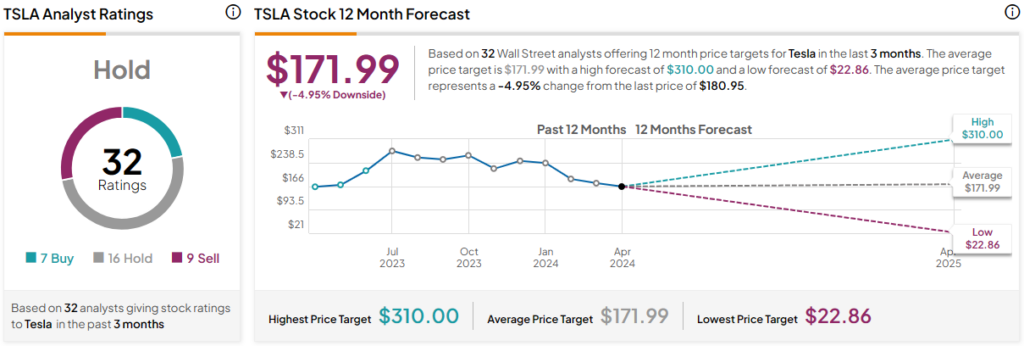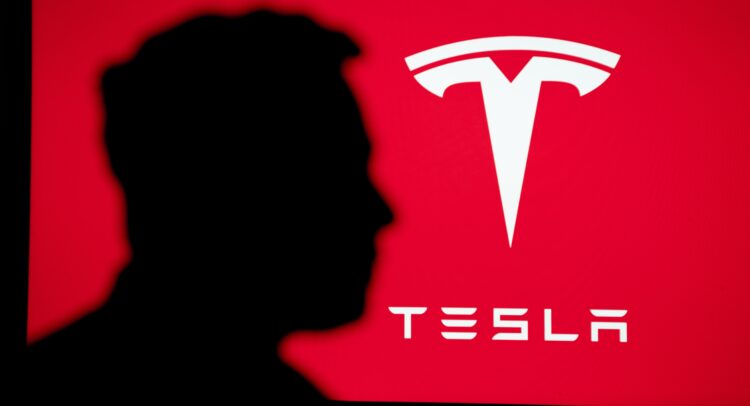While Tesla (NASDAQ:TSLA) has generated game-changing wealth for long-term shareholders, it has trailed the broader markets by a wide margin in the last two years. Tesla stock has returned a whopping 10,790% to investors since its IPO in July 2010. However, shares of the world’s leading electric vehicle manufacturer are currently down 57% from all-time highs, and now could be a good time to buy the dip.
Discover the Best Stocks and Maximize Your Portfolio:
- See what stocks are receiving strong buy ratings from top-rated analysts.
- Filter, analyze, and streamline your search for investment opportunities with TipRanks’ Stock Screener.
I am bullish on Tesla due to its strong market positioning, widening portfolio of vehicles, and the worldwide transition toward battery-powered vehicles. Let’s dive deeper.

Why Has Tesla Stock Soared Recently?
Tesla stock is up over 24% since it reported Q1 results last week. In Q1 of 2024, Tesla reported revenue of $21.3 billion and adjusted earnings of $0.45 per share. Comparatively, Wall Street expected revenue of $22.2 billion and earnings of $0.49 per share. Despite the revenue and earnings miss, Tesla stock surged over 12% in a single trading session after the company disclosed plans to begin producing cheaper EV vehicles within the next 12 months.
Earlier this week, Tesla stock popped 15.3% after the company stated it is positioned to launch its FSD (full self-driving) technology at scale in China. According to several reports, Tesla CEO Elon Musk visited China over the weekend and discussed data security measures with industry regulators.
Soon after the meeting, China paved the way for Tesla to launch its FSD software in the country. Due to data security concerns, Tesla’s FSD tech was previously deployed with certain restrictions in China.
Tesla Is Part of an Expanding Market
According to a report from Fortune Business Insights, the global electric vehicle market is forecast to expand from $385 billion in 2022 to $1.58 trillion in 2030, indicating an annual growth rate of almost 18%. An expanding addressable market provides Tesla with enough room to grow its top line while entering new growth markets such as Asia.
Tesla is the largest EV manufacturer in the U.S. and has a 6.7% share in China, the world’s biggest EV market. Last week, Tesla explained that it plans to use existing capabilities to build affordable cars and raise vehicle production by 50% from 2023. The company’s current manufacturing capacity is around three million vehicles. So, Tesla is likely to hit peak production capacity at existing facilities before investing in new factories.
However, it still increased capital expenditures by 34% to $2.77 billion in Q1 of 2024. The company emphasized that it is investing in growth verticals, including building out its AI infrastructure, production capacity, and service networks. To offset these costs and improve operational efficiency, Tesla recently undertook a cost-cutting exercise and laid off 10% of its workforce.
In its quarterly shareholder deck, Tesla stated, “The future is not only electric, but also autonomous. We believe scaled autonomy is only possible with data from millions of vehicles and an immense AI training cluster. We have, and continue to expand, both.”
A Low-Cost Vehicle Will be a Key Growth Driver
Tesla needs to find a way to increase vehicle production, revenue, and earnings, all of which should boost its market cap, going forward. The EV market is bound to attract additional players, resulting in a competitive marketplace. However, Tesla benefits from a first-mover advantage and a strong brand presence.
There are two more reasons for Tesla to gain momentum in the upcoming decade. First, it would need to launch new models across price points to target growth in emerging economies such as India and Latin America. The exclusive car company is now eying mass market production and very well be a household name in the next 10 years.
Second, Tesla might unlock another multi-billion-dollar revenue stream if the company can successfully showcase its FSD capabilities later this year. Investors should note that Tesla’s FSD software right now is an upgrade on its Autopilot Software, which was launched in 2020. So, Tesla’s cars are not fully autonomous and are equipped with features such as auto parking and other “level 2” driver-assistant capabilities.
Musk has long promised the launch of fully autonomous vehicles but has failed to deliver on these lofty goals, until now. Earlier this month, Musk announced that the robotaxi launch is scheduled for August 8.
If Tesla can successfully launch a fully autonomous robotaxi, it can enter the ride-hailing market to compete with incumbents such as Uber (NYSE:UBER) and Lyft (NASDAQ:LYFT). For context, in the last 12 months, Uber has reported revenue of $37 billion.
Tesla Needs to Tide Over Headwinds
Tesla’s top line narrowed by 9% year-over-year in Q1, its largest drop in more than a decade. Further, Tesla reported an 8.5% decline in vehicle deliveries for the March quarter.
In the last two years, Tesla has been wrestling with rising interest rates, inflation, and a sluggish macro environment, which has reduced demand for EVs. In fact, several legacy auto manufacturers, such as Ford (NYSE:F) and General Motors (NYSE:GM), scaled back EV production in 2024 due to lower-than-expected demand. Additionally, Tesla is facing rising competition from China-based manufacturers, including Byd (OTC:BYDDF) and NIO (NYSE:NIO).
To counter these headwinds, Tesla has reduced vehicle prices several times in the last 12 months, hoping to boost demand. However, these price cuts have lowered the EV giant’s profit margins, as gross profits were down 18% year-over-year while net income slumped 55% to $1.1 billion in Q1.
To regain investor confidence, Tesla must boost profitability and increase vehicle shipments, both of which seem difficult in the near term.
Is TSLA Stock a Buy, According to Analysts?
Out of the 35 analyst ratings given to TSLA stock, seven are Buys, 16 are Holds, and nine are Sells, indicating a Hold consensus rating. The average TSLA stock price target is $171.99, indicating downside potential of 5% from current levels.

Wall Street expects Tesla to report adjusted earnings of $2.58 per share with revenue of $100.4 billion in 2024. So, TSLA stock is priced at 70x forward earnings, which is quite steep given that the sector median is 14.8x.
That said, growth stocks trade at a premium, and Tesla is forecast to expand its earnings by roughly 40% to $3.61 per share in 2025.
The Takeaway
Tesla is a beaten-down growth stock that is trading well off its high. I believe the pullback in share prices provides long-term shareholders with an opportunity to buy the dip and benefit from outsized gains when market sentiment improves.









